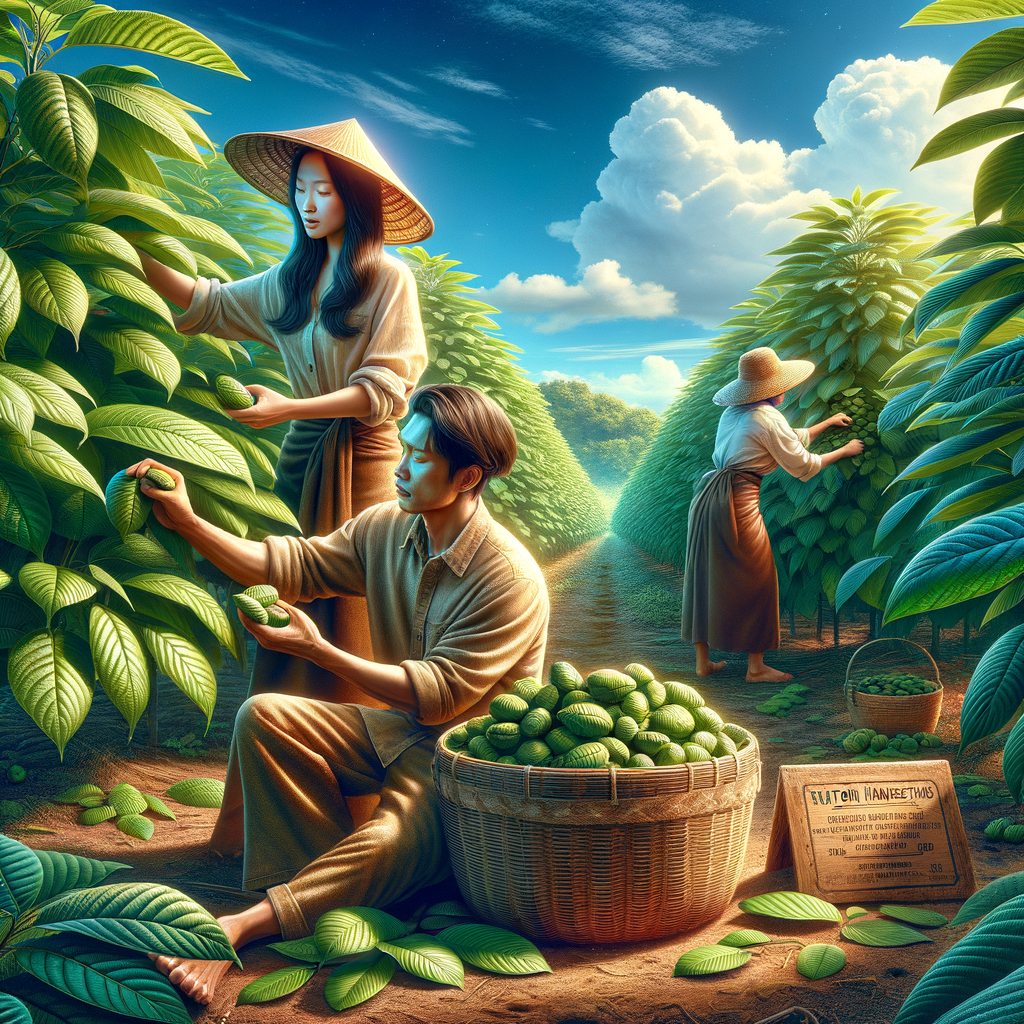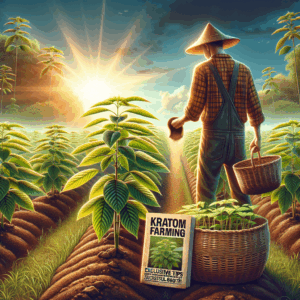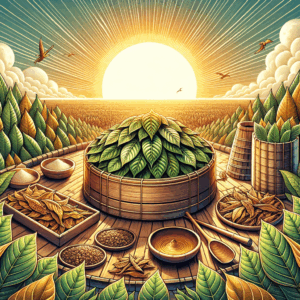
Kratom Harvesting: Exclusive Tips for Best Quality Yield
- Understanding Kratom: An Overview
- The Importance of Soil and Climate
- Choosing the Right Strain
- Timing Your Harvest
- Harvesting Techniques
- Drying and Curing Methods
- Quality Control Measures
- Storage for Optimal Freshness
- Common Mistakes to Avoid
- The Importance of Community
- Sustainable Practices for Kratom Farming
- Ethical Considerations
- Preparing for the Future of Kratom
- Conclusion
- FAQs
- References
Understanding Kratom: An Overview

Kratom, a tropical tree from Southeast Asia, has gained popularity for its leaves, which can enhance mood and energize the mind. Known scientifically as Mitragyna speciosa, this plant thrives in humid climates like those found in Thailand, Malaysia, and Indonesia. The leaves contain various alkaloids that can produce both stimulating and sedative effects, depending on their dosage.
Farmers often cultivate kratom in shaded areas, as this helps maintain humidity and temperature levels ideal for growth. The leaves can be processed into powders or extracts, which consumers use for various purposes, from relaxation to pain relief. Understanding kratom involves more than just knowing where it comes from; it’s essential to grasp how its harvesting can drastically influence the quality of the final product.
The Importance of Soil and Climate
When growing kratom, the quality of soil and climate truly matters. A nutrient-rich soil with good drainage encourages healthy growth. Organic matter enhances soil quality, allowing kratom trees to thrive. Farmers often incorporate compost or organic fertilizers to promote robust plant growth.
Climate affects how kratom develops. Ideally, kratom needs a warm climate with regular rainfall. A consistent temperature between 75°F and 90°F (24°C to 32°C) provides a suitable environment. Regions that experience seasonal changes can adversely affect the leaves’ potency. Therefore, knowing your specific climate’s characteristics can be a game-changer for maximizing yield.
Choosing the Right Strain
Not all kratom strains are created equal, and choosing the right one is vital. Each strain has unique characteristics, flavors, and effects. Popular strains include:
– Red Vein: Often used for relaxation and pain relief.
– Green Vein: Well-known for its mood-lifting properties.
– White Vein: Typically offers stimulation and increased energy.
The chosen strain can influence both the plant’s growth and the effects post-harvest. Researching which strains yield the best results based on your local conditions can lead to a higher quality and quantity of leaves.
Timing Your Harvest
Timing is everything when it comes to harvesting kratom. The leaves need to reach maturity for the best alkaloid profile. Typically, leaves are harvested when they are fully developed and mature. This usually occurs about three to five months after growth.
Monitoring the leaves is crucial; they should be a vibrant green color and firm to the touch. Harvesting too early can result in lower potency, while waiting too long could lead to leaf degradation.
Harvesting Techniques
Using the right techniques during harvest significantly affects the quality of kratom leaves. Most farmers prefer to select individual leaves rather than cutting entire branches. This method allows them to leave younger leaves to continue growing. The best practice is to use clean, sharp tools to avoid damaging the tree.
It’s essential to handle the leaves gently. Crushing or bruising the leaves can cause oxidation, affecting the final product’s quality. Farmers should also avoid harvesting during rainy periods. Wet leaves can encourage mold growth and degrade quality.
Drying and Curing Methods
Once harvested, the drying process starts. Proper drying is crucial to retaining the alkaloids within the leaves. Many farmers use sun drying, where leaves are spread out in a cool, shaded area. This method can take anywhere from several hours to several days.
Alternatively, some choose to use dehydrators or ovens for faster results. This method allows for better control over heat and moisture. However, it’s essential to ensure that the temperature remains low to prevent losing valuable alkaloids.
After drying, curing the leaves further enhances their quality. Curing lets flavors develop and can increase potency. In this step, the dried leaves are stored in a cool, dark place in airtight containers. This process can take several weeks, but the outcome is often worth the wait.
Quality Control Measures
Quality control cannot be overlooked in kratom harvesting. Various factors can influence the final product, so establishing a robust quality control system is vital. Testing for contaminants and alkaloid profiles can ensure that the kratom meets safety and effectiveness standards.
Using a simple inspection process can also help. Check moisture content and ensure that no mold is present. Regularly sampling your product for taste and texture will also give insights into its quality. If you’re operating on a larger scale, consider implementing lab tests to analyze the alkaloid profile precisely.
Storage for Optimal Freshness
Storing kratom properly is as important as how it’s harvested. After drying and curing, you must keep the leaves fresh. Ideally, store them in a dark, cool place away from sunlight.
Using airtight containers helps to prevent exposure to moisture and air, which can degrade quality. Glass jars or vacuum-sealed bags often work best. It’s crucial to keep the storage conditions consistent, as changes in humidity or temperature can lead to spoilage.
Common Mistakes to Avoid
Many beginners make mistakes that lead to reduced quality. One major pitfall is improper timing for harvest. As discussed, timing can make or break your yield. Harvesting leaves too early can lead to weaker alkaloid concentration.
Additionally, neglecting to monitor humidity levels while drying can promote mold growth. Avoid using unsanitary tools; cleanliness is critical in preventing contaminants. Last but not least, don’t overlook the importance of curing the leaves; skipping this step can limit flavor and potency.
The Importance of Community
Joining a kratom-growing community can provide valuable insights. Experienced growers often share tips and tricks that can help improve your yield. Online forums, social media groups, and local associations offer resources and connections.
Networking with other farmers allows you to exchange experiences and learn new techniques. It also helps to stay updated on market trends, consumer preferences, and regulatory changes. Engaging with others keeps your knowledge fresh and relevant.
Sustainable Practices for Kratom Farming
Implementing sustainable practices is crucial for the future of kratom farming. This includes using organic fertilizers and avoiding harmful pesticides. Sustainable methods not only protect the environment but also enhance the quality of your crop.
Planting cover crops can help maintain soil health. Additionally, responsible harvesting ensures that the trees can continue to thrive year after year. By taking steps to protect the ecosystem, growers contribute to a sustainable industry and can improve their own yields.
Ethical Considerations
With the rise in popularity of kratom, ethical considerations come into play. Sustainable harvesting practices protect both the plant and the local communities that rely on it. Educating consumers about the importance of ethical sourcing is also of paramount importance.
Choosing suppliers who follow ethical practices shows a commitment to the industry as a whole. Encourage others to support responsible companies, and you can influence positive change in the market.
Preparing for the Future of Kratom
As the kratom industry continues to evolve, staying informed will benefit all growers. Regulatory changes, consumer demand, and research developments can all impact your practices. Keeping tabs on news sources and publications will help you adapt to these changes.
Furthermore, exploring innovations in farming technologies can lead to better yields and quality. There’s a wealth of knowledge available, and seeking it out can set you apart from other growers.
Conclusion
Kratom harvesting can be both a rewarding and challenging venture. With the right techniques and understanding, you can yield high-quality product. Pay attention to vital factors such as soil, timing, and proper storage. Stay connected with the community, and always strive for sustainable practices. The journey may be long, but the fruits of your labor can be immensely rewarding.
FAQs
1. What is the best time of year to harvest kratom?
Harvesting typically occurs when the leaves are mature, which is about three to five months after growth starts.
2. How do I know if my kratom leaves are ready to harvest?
Leaves should be a vibrant green color and firm to the touch when they are mature.
3. Can I grow kratom in cooler climates?
Kratom prefers warm, humid conditions. Growing it in cooler climates may be challenging without proper care.
4. What are the main alkaloids in kratom?
Mitragynine and 7-hydroxymitragynine are the primary alkaloids that provide kratom’s effects.
5. How do I prevent mold during the drying process?
Dry kratom leaves in a well-ventilated, cool, and dark space to minimize moisture accumulation.
6. Can kratom be grown indoors?
Yes, with proper lighting and humidity control, kratom can be successfully cultivated indoors.
7. How long does it take to dry kratom leaves?
Sun drying can take several hours to days, while using dehydrators may speed up the process.
8. What type of soil is best for kratom?
Well-drained, nutrient-rich soil enriched with organic matter promotes healthy growth.
9. Are there any legal restrictions regarding kratom farming?
Regulations vary by location so it’s crucial to check local laws regarding kratom cultivation.
10. Can kratom leaves be harvested multiple times?
Yes, individual leaves can be harvested while allowing younger leaves to continue growing.
References
1. Kratom Wiki – History and Uses
2. American Kratom Association – Industry Standards
3. Mitragyna Speciosa – Botanical Overview
4. Kratom: A Review of Its Pharmacology and Therapeutics
5. Sustainable Practices in Herbal Farming
6. Kratom Growing Guide
7. Community Resources and Forums


